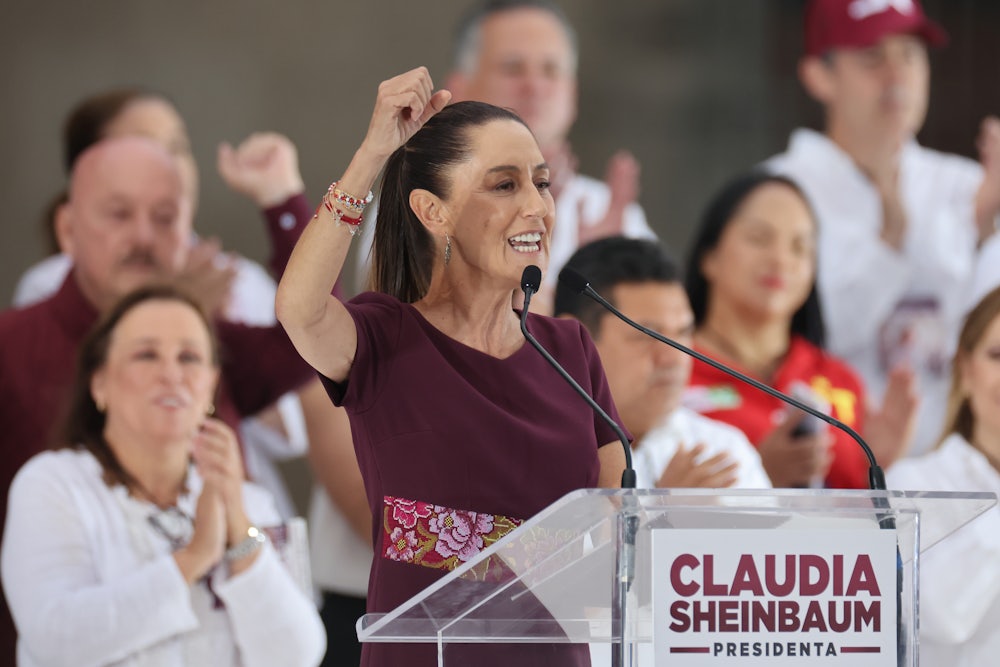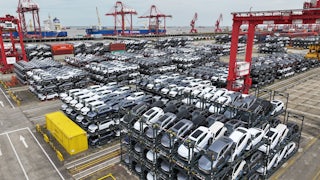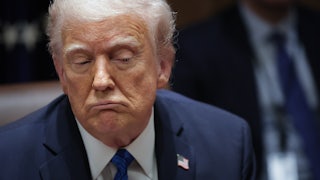On Sunday, Mexico is likely to elect its first woman president: a left-wing climate scientist, contributing author to a report of the Intergovernmental Panel on Climate Change, and former mayor of Mexico City. Claudia Sheinbaum, who’s running in a coalition led by her ruling Morena party, is widely favored to succeed her longtime ally Andrés Manuel López Obrador, known as AMLO. Sunday’s elections will also come on the heels of a deadly heat wave and a dire, climate-fueled water crisis that could see Mexico City run out of water as early as next month. So what could a prospective Sheinbaum administration mean for Mexico’s climate policies?
The water crisis hasn’t become a top issue in this election, says Edwin Ackerman, a sociology professor specializing in Latin American studies at Syracuse University’s Maxwell School of Citizenship and Public Affairs. That’s thanks in part, he explains, to the fact that states governed by parties across the political spectrum have faced their own water crises in recent years, “so it’s not really politicized in a concrete way.” While opposition candidate Xóchitl Gálvez’s center-right coalition has tried to focus the election on questions of crime and violence—especially that related to drug trafficking—much of the debate domestically has revolved around the future of a suite of popular social programs implemented by AMLO’s government, including a universal pension for Mexicans over the age of 65 as well as cash transfers to students, working mothers, and people with disabilities. “It’s electorally unviable to openly criticize them,” Ackerman says. Gálvez—whose National Action Party voted against those programs—is now in the awkward position of both defending their existence while criticizing them as wasteful, clientelistic handouts to the poor.
Sheinbaum, who served as AMLO’s environment secretary, is looking to build on the success of those social programs, which have also involved raising the minimum wage and making it easier to organize new unions. One of the areas where she’s likely to differ the most from her predecessor is in her approach to climate and environmental issues.
Sheinbaum unveiled her climate platform on March 18, a national holiday commemorating the 1938 nationalization of Mexico’s oil reserves. Her platform includes a goal to have 50 percent of Mexico’s electricity demand met through zero-carbon sources by 2030, using a mix of wind and solar as well as hydroelectric and geothermal power; investing $13.6 billion in renewable energy; adding nearly 2,400 miles of transmission lines; and expanding on her work as mayor of Mexico City in expanding electrified mass transit via buses and passenger trains.
Sheinbaum’s climate campaign leans heavily on strengthening and transforming Mexico’s state-owned enterprises, including beleaguered oil producer Pemex and the utility Comisión Federal de Electricidad, or CFA. This might sound odd for readers in the United States, where—with notable exceptions—both electricity and energy production are largely controlled by for-profit companies. Mexico’s Constitution, though, stipulates that the country’s transmission and distribution lines must be state-owned, while generation and retail capacities—i.e., who makes the power and who you pay your bills to—can be run by the private sector. AMLO’s government has looked to reverse power-sector liberalization carried out by Enrique Peña Nieto’s government starting in 2013, which guaranteed private companies a segment of that market. Now more than 60 percent of power generation must be state-owned.
Private energy developers that have launched legal challenges to AMLO’s reforms under the U.S.-Mexico-Canada Agreement, or USMCA, have argued that these changes threaten both their profits and climate and environmental goals. They point to the fact that the state-owned utility CFA’s generation capacity is largely fossil fuel–powered. “By that narrative, public energy is dirty and green energy is coming from the private sector,” says Ackerman. The reality is more complicated. While AMLO has certainly emphasized a largely fossil fuel–powered vision of energy sovereignty, Ackerman notes—pushing through a refinery development in the southern state of Tabasco, and other infrastructure projects that have been controversial among environmental advocates—there’s no straightforward reason why state-owned companies are fated to be dirtier than private-sector energy developers.
Alonso Romero, the Sheinbaum campaign’s energy ambassador of dialogues for transformation, sees Mexico’s state-owned enterprises as an asset not just for the energy transition but for building competitive green export sectors. An early step will be refinancing Pemex’s considerable debt; the world’s most indebted oil producer, Pemex has $6.8 billion in bonds coming due next year. In renegotiating Pemex’s debt, Sheinbaum has stated that she intends for its long-term plans to include new investments in lower-carbon lines of business. “In the face of climate change,” she said last month, “Pemex has to enter new markets.”
A Sheinbaum government, Romero told me during our conversation last Saturday, will emphasize coordination among Mexico’s state-owned firms so as to best play to their strengths. Mexico, for instance, has massive geothermal energy reserves, which can be accessed with drilling techniques already utilized by Pemex workers and engineers. That zero-carbon power could then be used for green hydrogen development in partnership with CFE, which can leverage its own expertise in scaling up wind and solar power. Having holistic planning across government departments and state-owned enterprises, Romero told me, can help to meet today’s energy needs while planning for the future and protecting ratepayers from volatility.
“It’s cheaper and more efficient to implement these policies through state-owned companies,” Romero told me. “We believe that state-owned companies have a longer-term horizon that can sustain these kinds of investments. Sometimes private companies don’t, or the investment and return horizons are not within the range that investors are expecting, so they need to be incentivized and subsidized,” he added. These investments will still involve a sizable role for the private sector—particularly for financing—but higher-level coordination, Romero argues, can offer investors, certainly in terms of pricing and scheduling, things that private sector–led projects often can’t. In the U.S., for instance, several high-profile offshore wind projects have been canceled in recent months by developers citing supply chain constraints, insufficient subsidies, and related disinterest from investors seeking larger and steadier returns.
“Energy transitions are faster if implemented by the state,” Romero said, and better at meeting goals other than profit, like expanding access to cleaner and more affordable electricity. “It’s not that it’s not possible with the private sector only, but it’s faster, easier, and cheaper to mandate a public company do something rather than incentivize and subsidize private companies to do something they might not end up doing.” There’s evidence to back up that approach, even if it might seem a bit alien in the U.S. Researchers at MIT’s Center for Energy and Environmental Policy Research found that state-owned utilities in the European Union had a “significantly higher tendency” to invest in renewables than their private-sector counterparts.
Not all of Sheinbaum’s plans will be great news for climate advocates. Her plan for PEMEX involves boosting refinery capacity, investing heavily in petrochemicals, and increasing oil production to 1.8 million barrels per day before stabilizing it there. “We believe that Pemex needs to continue to produce oil and gas,” Romero told me, noting that Pemex won’t follow a similar path to Dong Energy, the Danish state-owned fossil fuel firm that has transformed into a major wind power developer, Ørsted.
Private investors may also be angry, since they stand to lose market share to state-owned competitors. Though the U.S.-Mexico-Canada Agreement excised many of the dubious investor-state dispute settlement clauses found in its predecessor—the North American Free Trade Agreement, or Nafta—investors in Mexico’s energy sector are still eligible to sue the state for infringing on their expected profits. Fourteen of the 16 claims brought against governments under the USMCA have been brought against Mexico, many of them asserting that the government’s preference for state-owned generation unfairly targets their own, cleaner energy projects. The U.S. itself, in 2022, requested “consultations” under that treaty in the name of the climate, alleging (among other things) that amendments to Mexico’s electricity law would “prioritize the distribution of CFE-generated power over cleaner sources of energy provided by private sector suppliers, such as wind and solar.”
How the U.S. might react to a state-led energy transition—and how successful that transition will be—remains to be seen. The more immediate concern for a Sheinbaum government over trade with its northern neighbor relates to a country very far away from either: China. As the U.S. implements increasingly punitive tariffs on Chinese electric vehicles, semiconductors, and renewables, that is, politicians here have fretted that Chinese firms will see Mexico as a place to sneak their products into the U.S. under the auspices of its free trade partner just to the south. Given that the United States is Mexico’s most important trading partner, AMLO’s government has trodden carefully on this front, declining, for example, to extend incentives like cheaper land and tax breaks to Chinese automaker BYD as it looks to build a plant there. In any case, Mexico stands to see considerable investment as companies look to chase U.S. clean energy incentives requiring that an escalating percentage of components to green technologies, including E.V.s, be sourced either in the U.S. or from countries with which it has a free trade agreement.
Romero stressed that Sheinbaum’s government would be keen to avoid Mexico being merely a source of cheap labor and resources in the energy transition, for companies either from the U.S. or who are looking for ways to access that market. “We want to have high-paying jobs here,” he told me. “We lived through that with the first wave of ‘nearshoring’ with Nafta. Very high up on the agenda is to invest in technology and basic science. It’s going to be an industrial policy more like the Entrepreneurial State,” he said, referencing Mariana Mazzucato’s 2011 book on the central role of governments in fueling innovation. “The state must take risks. The state must be a de-risking agent, but also the state must grow capacities in the public sector.”
Part of that approach will be developing the country’s lithium sector. Unlike in the nearby “lithium triangle,” spanning Chile, Argentina, and Bolivia, the vast majority of Mexico’s comparatively modest lithium reserves are held in clay in the Sonoran Desert. Accessing those resources is extraordinarily difficult, which is why Sheinbaum is championing a government-led research effort led by the Mexican Petroleum Institute, or IMP. As of 2022, Mexico’s lithium is legally treated as a “public utility” there, and its extraction will be overseen by the newly created state-owned firm Litio Para Mexico, or LitioMx. Other South American governments have similar arrangements, and Romero signaled that Sheinbaum’s team would be keen to learn from them. In the long run, the hope is for Mexico not just to extract and export lithium but to refine it in-country, as well, as part of fully developed supply chains that include battery production and electric vehicle manufacturing for both export and internal consumption.
As Sheinbaum continues to enjoy a commanding lead over Gálvez, Mexico is poised to make history this weekend in electing its first woman as president. Depending on the success of Sheinbaum’s plans, it could also break new ground in another way: by forging a new balance between the public and private sectors’ respective roles in navigating the energy transition.








